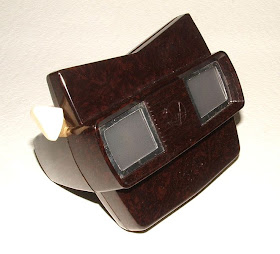Anyway, Mom went in this one booth where the lady had a lot of old postcards for sale and also some stereographic cards. Maybe you have seen these kinds of cards before. They have the same picture printed twice, side-by-side, except one picture is a little farther off to one side than the other one. And the way you're supposed to look at the card is you put it in a stereoscope which you hold up to your eyes. This makes the picture look like it has three dimensions, just like things look in real life. Unless you only have one eye.
 |
| A type of stereoscope invented by Oliver Wendell Holmes. |
Back in the old days, like at the end of the 19th century and the start of the 20th, people spent a lot of time looking at pictures in stereoscopes because they didn't have TVs or movies or iPads to look at. Lots of the stereographs were photos of faraway places such as Egypt or Yellowstone Park, and people learned what these places looked like by looking through their stereoscopes.
 |
| A painting done by Jacob Spoel in the 1850s or 60s. The women on the right are looking at a stereoscope. |
Mom does not own a stereoscope, so she never thought about buying a stereographic card before. But when she was at the flea market, she started looking at these cards, and a bunch of them were from Africa. Mom was hoping she would find one with a basenji in it, or at least with some village dogs, but she didn't. Most of the pictures were from East Africa. But then she found one from the Congo, and she decided to buy it. She wasn't sure if there were any dogs in it or not because the picture was taken from a distance. I sniffed it very carefully, but I did not smell any dogs. And Mom looked at it with a magnifying glass, and she didn't see any dogs, so we think these poor village people didn't have a single basenji, which was a very sad state of affairs.
 |
| Turumbu village near Yakusu, Congo Free State. |
There is no date on the stereograph, but we're guessing the picture might have been taken around 1904 or 1905. Or maybe earlier. The people were called the Turumbu, and they lived in the "Congo Free State." Of course, the Congo has changed its name about 40 times, and the whole area has a very complicated history. But here's what I learned about the Congo Free State. It was a great big area in the middle of Africa that was under the personal, private control of Leopold II, who was the King of Belgium. He was not a very nice landowner because he made the native people work really hard to produce ivory, rubber, and minerals which he then sold to make himself rich.
King Leopold named the area the Congo Free State in 1885, and it kept this name until 1908. The King treated the Congolese people very badly, and he did not care about the country's natural resources. All the horrible stuff that he was doing in Africa got to be a huge scandal, and finally the Belgian government forced the King off the throne. After that, they made a colony out of the Congo Free State, and they called it the Belgian Congo.
 |
| Detail of stereoscopic photo |
Okay, well, the photo Mom bought shows where the Turumbu people have been cutting down trees to make homes in the forest. Some of the houses have log walls, like the cabin that Abe Lincoln grew up in. Other people who live in this area are the Lokele, Bakumu, Wagenya Bamanga, and Tovoke. All these groups speak the Lombo language and live close to the Congo River. The average rainfall there every year is 71 inches (1,800 ml), and the average temperature is 77.9º F (25.5º C). The humidity is usually about 90%. Crops don't grow very well in the soil, so people often do the slash-and-burn thing to get new fields.
 |
| The Yakusu Mission today. Photo by philKin |
Turumbu farmers grow rice and maize to sell for cash, and they grow cassava and plantain for themselves to eat. Also, they hunt, fish, and make handicrafts and alcoholic beverages. The nearest major cities are Kampala, Kigali, Kisumu, and Eldoret, but the roads are in bad shape, and they can't be used at all in the rainy season.
 |
| Mission church interior. Photo by philKin. |
 |
| View of the Congo River from Yakusu. Photo by PhilKin. |
When I was looking for information about Yakusu, I found a bunch of recent pictures on Google Earth of the mission and town now. These were all taken by a man who uses the name philKin, and he speaks French. One thing that was interesting was that 2 or 3 people commented (in English) on the photo of the old colonial house and said they or their parents had been missionaries in Yakusu, and they had lived in that very house. But nobody said whether they owned a basenji or not.
 |
| Old colonial house lived in by missionaries. Photo by PhilKin |
So that is all I know to tell you about the stereograph of Turumbu people that Mom bought at the flea market. But I will just mention that the modern version of the stereoscope is the View-Master™, which came out in 1939. The View-Master™ has disks with little color stereoscopic views. The early View-Master™ reels had lots of travel and scenery reels, but now the reels are mostly for children. I am guessing that View-Master™ does not have any pictures of African women who are not fully clothed.
 |
| Early model of View-Master™ |
 |
| Mom's View-Master™, Christmas 1958 |

No comments:
Post a Comment